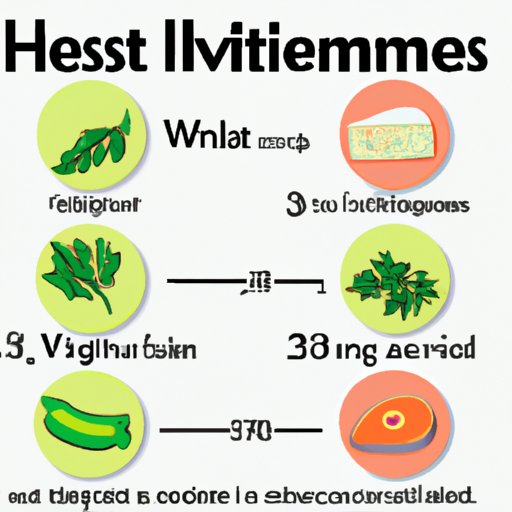
I. Introduction
Have you been experiencing unexplained symptoms like migraines, rashes, or digestive issues? Are you struggling with allergies or an autoimmune condition? It might be time to consider a low histamine diet. In this article, we’ll explore what is a low histamine diet and why it may be important for your health.
II. What is a Low Histamine Diet?
Before diving into what is a low histamine diet, it’s important to understand what histamine is. Histamine is a natural substance that your body produces as part of your immune response. It’s also found in certain foods, especially those that have been aged or fermented. Foods that are high in histamine can cause an allergic-like reaction in your body, leading to symptoms like itching, hives, headaches, and digestive problems.
High histamine levels can occur for various reasons, including allergies, gut dysbiosis, genetic factors, or medication use. For some people, reducing histamine intake can help alleviate symptoms and improve their overall health.
A low histamine diet is a way of eating that focuses on avoiding or limiting foods that are high in histamine. The goal is to reduce the amount of histamine that enters your body, which can help decrease inflammation and relieve symptoms.
III. Foods to Include in a Low Histamine Diet
While a low histamine diet may seem restrictive, there are still plenty of low-histamine foods to choose from. Here are some food choices to include in a low histamine diet:
- Fresh fruits: apples, pears, melons, mango, papaya, kiwi, grapes, berries
- Fresh vegetables: sweet potatoes, carrots, broccoli, cauliflower, cucumber, lettuce, zucchini, squash
- Fresh meats: chicken, turkey, fish, beef, lamb
- Grains: rice, quinoa, oats
- Dairy substitutes: coconut milk, almond milk, rice milk, hemp milk
- Fats and oils: olive oil, coconut oil, avocado oil
- Herbs and spices: basil, oregano, thyme, mint, rosemary, cinnamon, ginger
- Beverages: water, herbal tea, fresh fruit juices
Here’s a sample day meal plan for a low histamine diet:
- Breakfast: Rice cereal with almond milk and fresh fruit
- Lunch: Grilled chicken salad with lettuce, cucumber, and carrots
- Snack: Fresh berries with coconut yogurt
- Dinner: Baked salmon with roasted sweet potatoes and steamed broccoli
IV. Foods to Avoid on a Low Histamine Diet
While there are many foods that are safe to eat on a low histamine diet, there are also a number of foods and drinks that should be avoided. Here are some high-histamine foods to steer clear of:
- Aged or fermented foods: cheese, yogurt, kefir, sour cream, sauerkraut, kimchi, tofu, tempeh, miso
- Cured or processed meats: bacon, ham, salami, pepperoni, hot dogs, luncheon meats
- Shellfish and certain fish: tuna, mackerel, sardines, anchovies, shrimp, lobster, crab
- Nuts and seeds: peanuts, cashews, walnuts, pecans
- Chocolate and cocoa
- Citrus fruits: oranges, lemons, limes, grapefruit
- Tomatoes and tomato products
- Spinach and other leafy greens
- Alcohol, especially red wine and beer
It’s also important to be aware of hidden sources of histamine, like leftovers and canned or packaged foods. Additionally, certain cooking methods can increase histamine levels in foods, such as grilling, smoking, and high-heat frying.

V. Benefits of a Low Histamine Diet
Following a low histamine diet can offer numerous benefits to your health, beyond reducing allergy symptoms. Here are some known advantages of a low histamine diet:
- Improved gut health: reducing histamine intake can help heal a damaged gut lining, reducing inflammation and supporting overall gut health.
- Reduced inflammation: histamine is an inflammatory substance, and lowering its levels can help reduce chronic inflammation in the body, which is associated with numerous health conditions.
- Improved sleep: histamine can interfere with sleep, so reducing its levels can help improve sleep quality and duration.
- Improved mood: histamine can also affect neurotransmitters in the brain, leading to symptoms like anxiety, depression, and brain fog. Reducing histamine intake can improve mood and cognitive function.
VI. Pros and Cons of a Low Histamine Diet
While there are certainly benefits to following a low histamine diet, it’s important to also consider the potential drawbacks. Here are some of the advantages and disadvantages of a low histamine diet:
A. Advantages of following a low histamine diet
- Relief of allergy and intolerance symptoms
- Overall improved health and well-being
- Increased awareness of food choices and their effects on the body
B. Potential drawbacks of a low histamine diet
- Dietary restrictions and potential nutrient deficiencies
- Potentially higher food costs and meal planning requirements
- Social limitations when dining out or with others
- Not suitable for everyone, particularly those with certain health conditions or on certain medications
It’s important to note that not everyone may benefit from a low histamine diet, and some people may even experience drawbacks from it. It’s important to consult with a healthcare provider before starting any new dietary regimen.
VII. How to Start a Low Histamine Diet
If you’ve decided to try a low histamine diet, the following tips can help make the transition easier:
- Do your research: become familiar with which foods are low or high in histamine
- Plan your meals and snacks in advance
- Gradually reduce high histamine foods in your diet, instead of cutting them out all at once
- Focus on nutrient-dense, whole foods to ensure a balanced diet
- Supplement with nutrients that may be lacking in a low histamine diet, like vitamin C, vitamin B6, and copper
When grocery shopping, look for fresh, non-processed foods and avoid canned or packaged products whenever possible. Consider buying frozen foods if fresh options aren’t available.
Here are some recipe ideas for a low-histamine diet:
- Cauliflower fried rice with chicken and vegetables
- Stuffed sweet potatoes with ground turkey and spinach
- Baked salmon with roasted Brussels sprouts and sweet potatoes
- Chicken lettuce wraps with tofu and vegetables
VIII. Maintaining a Low Histamine Diet When Eating Out
Eating out on a low histamine diet can be challenging, but it’s not impossible. Here are some tips for dining out with histamine intolerance:
- Research restaurant menus in advance and look for low histamine options
- Ask the server about ingredients and preparation methods, and make special requests if necessary
- Avoid sauces, dressings, and condiments, which may be high in histamine
- Choose simple, grilled or baked dishes with fresh, low-histamine ingredients
- Eat a small snack before going out to eat to prevent overeating or making poor food choices
IX. Conclusion
A low histamine diet may be a helpful way to reduce allergy symptoms, inflammation, and other health issues related to high histamine levels. While it does require careful planning and some dietary restrictions, the benefits can be significant.
If you’re considering a low histamine diet, talk to your healthcare provider first to see if it may be appropriate for you. If so, use the tips and guidelines above to get started on your journey towards a healthier, happier you.




